




What Are Chromosomes?
For a simple answer to the question of ‘what are chromosomes?’, we can say that chromosomes are minute complexes present inside cells which are mainly composed of DNA and proteins. Information present on chromosomes functions as an instructor that instructs cells on how to operate and reproduce. Your chromosomes are the main supply of distinctive characteristics that you will acquire since the day you are born, such as hair colour and height.
Chromosomes are typically invisible to us. Even with a strong microscope, we can't see them because they are so tiny and thin. The chromosomes, on the other hand, wind themselves up and pack tightly when a cell is about to divide. Chromosomes can be seen by scientists using a powerful microscope during the division of cells. They typically exist in pairs.
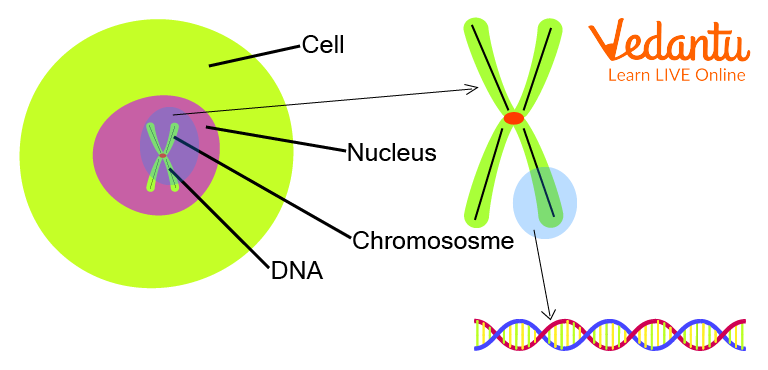
Location and Constituent of Chromosomes
Where Are Chromosomes Found?
If you look at a cell under a microscope, you can see that chromosomes are present inside the nucleus and are usually paired with each. Each cell of varied types of life forms contains a variable set number of chromosomes. For example, normally, each human cell contains 46 chromosomes or 23 pairs of chromosomes. But can vary in the case of polyploidy or disruptive distribution of chromosomes like in the case of down syndrome in which 3 copies of chromosome 21 happen.
How Are Chromosomes Formed?
DNA generally resides in the nucleoplasm, the sticky matrix fluid inside the nucleus, of cells with nuclei as fine fibres. When DNA wraps around a number of tiny proteins known as histones, these strands, which are known as chromatin, start to form. The resultant aggregates, known as nucleosomes, are joined with each other to create an appearance of a string containing beads.
Chromatin is synthesised by winding and compacting the nucleosome threads. Chromatin gets further spiralled into thicker structures called chromosomes as a cell begins to divide for reproduction. And that is how chromosomes are formed. Chromosomes are distributed evenly across the progeny cells after cellular division.
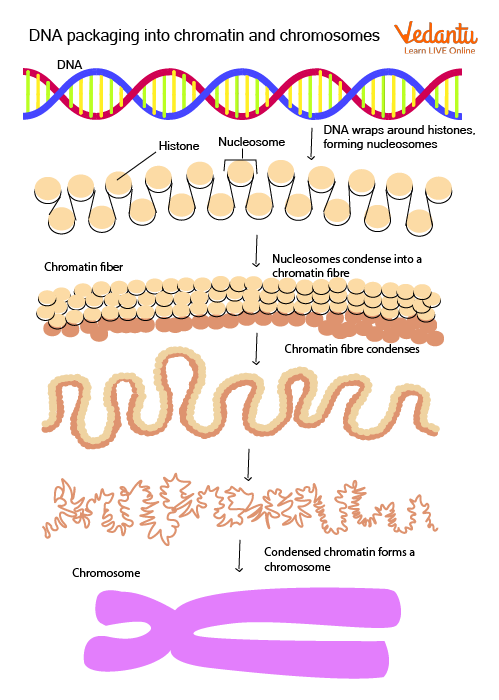
Formation of Chromosome
Describe the Structure of Chromosomes
The structure of a chromosome is called chromatin state or thread-like state when a cell is not dividing (this is referred to as the interphase of the cell cycle). It is an extremely long, thin strand in this form. That strand copies itself and shortens into tube-like structures when the cell begins to divide. The two tubes are compressed together at a location known as the centromere before division. The tubes' "p arms" and "q arms" refer to their shorter and longer respective arms.
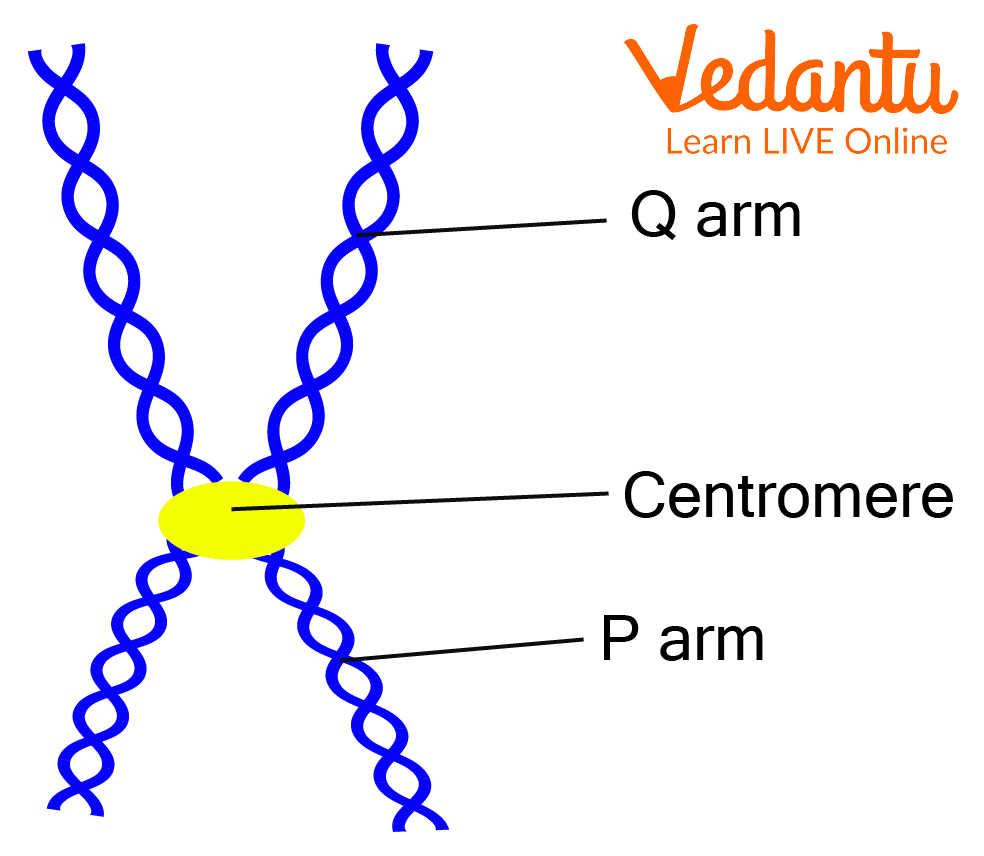
Short and Long Arms of Chromosomes
Types of Chromosomes Based on Position of Centromere
Metacentric- Centromere is present at the centre resulting in equal p and q arms.
Submetacentric- Centromere is present slightly away from the centre resulting in unequal p and q arms.
Acrocentric- Centromere is present slightly below the tip resulting in tiny p arms.
Telocentric- Centromere is present at the end of the tip resulting in no p arms.
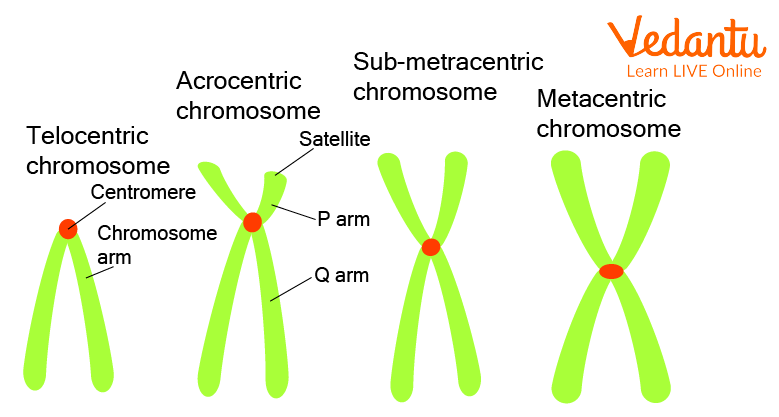
Types of Chromosomes Based on The Position of the Centromere
Human Chromosomes
Humans have 46 chromosomes in all, which are divided into 23 different pairs, as was previously mentioned. Each of our parents gives us 23 chromosomes. These pairings are numbered by scientists from 1 to 22, plus an additional pair is known as the "X/Y" pair. You can tell if you are a man or a woman by your X/Y pair. Males have an X and a Y chromosome, known as the XY, while females have two X chromosomes, known as the XX.
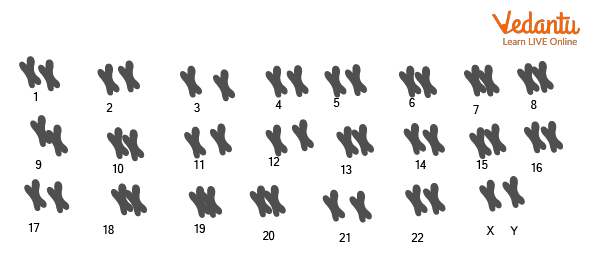
Human Chromosomes
Function of Chromosomes
Below are listed some of the functions of chromosomes.
The main objective of chromosomes is to pass genetic traits from one generation on to the next. Chromosomes further play a vital role during the processes of development like reproduction, repair, and regeneration that are necessary for DNA and chromosomal preservation.
The DNA is guarded by chromosomes from tangling and damage with the help of chromosomes
During cell division, spindle fibres linked to the centromere aid in the movement of the chromosome.
Numerous proteins found in the body are carefully coded by thousands of genes present on each chromosome.
Facts about Chromosomes
The following lists some of the facts about chromosomes.
The number, shape, and size of chromosomes are different in different organisms.
Bacterial cells have an additional set of DNA other than genetic chromosomes.
Some chromosomes have secondary constrictions on them like that of a centromere called a satellite.
Chromosomes of an organism determine whether they are male or female.
Summary
Typically, the bacterial genome does have the shape of a circular chromosome that is found inside the cytoplasm. Instead, in eukaryotes, the genetic material is tightly wrapped in linear chromosomes and conserved in the nucleus. To conclude all the learnings, we can say that chromosomes are responsible for the genetic transfer of traits or characters from the parent generation to the offspring and thereby help in the maintenance of characters over generations. Chromosomes transfer characters from one generation to the other.
FAQs on Facts about Chromosomes to Learn
1. What exactly is a chromosome and where is it located within a cell?
A chromosome is a thread-like structure located inside the nucleus of eukaryotic cells (like in plants and animals). It is essentially a highly organised and condensed package of DNA (Deoxyribonucleic acid) and proteins called histones. This efficient packaging allows the vast amount of genetic information to fit within the tiny space of the nucleus. In prokaryotic cells, which lack a nucleus, the chromosome is found in a region called the nucleoid.
2. What are chromosomes made of?
Chromosomes are primarily composed of two main components:
DNA (Deoxyribonucleic acid): This is the genetic material that carries the instructions for building and maintaining an organism.
Proteins: The most important proteins are histones. DNA wraps tightly around these histone proteins, which helps to condense the long DNA strands into a compact structure. This DNA-protein complex is known as nucleosome, which further coils to form the chromosome.
3. How many chromosomes do humans have?
A typical human cell contains 46 chromosomes, arranged in 23 pairs. Out of these:
22 pairs are autosomes: These chromosomes carry the genetic information for most of the body's traits and functions, not related to sex determination.
1 pair are sex chromosomes: These determine the biological sex of an individual. Females have two X chromosomes (XX), while males have one X and one Y chromosome (XY). The sex determination in humans is therefore dependent on the chromosome carried by the sperm.
4. What is the difference between chromatin and a chromosome?
Chromatin and chromosomes are essentially the same material (DNA and proteins) but in different states of condensation. The key difference lies in their structure and visibility during the cell cycle:
Chromatin is the less condensed, tangled form of DNA found in the nucleus when the cell is not dividing. It is accessible for processes like transcription.
A chromosome is the highly condensed, organised structure that chromatin forms just before and during cell division (mitosis and meiosis). This compact form allows for the orderly segregation of genetic material to daughter cells. You can learn more about the difference between chromatin and chromosomes for a deeper understanding.
5. What is the primary function of chromosomes?
The primary function of chromosomes is to carry and transfer genetic information accurately from one generation of cells to the next, and from parents to offspring. They act as the storage units for DNA, ensuring that this complex molecule is protected, managed, and distributed correctly during cell division. Without this organisation, processes like growth, repair, and reproduction would be impossible.
6. Why are chromosomes visible only during cell division?
During most of a cell's life (interphase), the genetic material exists as thin, uncoiled strands called chromatin to allow access for reading genes. Just before a cell divides, this chromatin undergoes extreme condensation and coiling. It wraps tightly around proteins, forming the compact, dense structures we recognise as chromosomes. This packaging is necessary to prevent the long DNA strands from getting tangled or breaking during their separation into two new daughter cells. Therefore, they are only thick and distinct enough to be visible with a light microscope during this phase.
7. What happens if there is an error in the number of chromosomes?
An error in the number of chromosomes, known as aneuploidy, can lead to serious genetic conditions. This usually occurs due to a failure of chromosomes to separate properly during meiosis (a process called nondisjunction). For example:
Down Syndrome (Trisomy 21): An individual has three copies of chromosome 21 instead of the usual two.
Turner Syndrome: A female has only one X chromosome instead of two.
Klinefelter Syndrome: A male has an extra X chromosome (XXY).
These chromosomal disorders in humans often result in distinct physical and developmental characteristics.
8. Do all living organisms have the same number of chromosomes?
No, the number of chromosomes varies significantly among different species. The chromosome number is not an indicator of an organism's complexity. For example:
A fruit fly has 8 chromosomes.
A dog has 78 chromosomes.
A potato plant has 48 chromosomes.
A fern (Ophioglossum reticulatum) has over 1,200 chromosomes.
What matters is the genetic information contained within the chromosomes, not the quantity of chromosomes themselves.
9. How do chromosomes contribute to heredity?
Chromosomes are the vehicles of heredity. They contain genes, which are specific segments of DNA that code for particular traits. During sexual reproduction, each parent contributes one chromosome from each pair to their offspring. This combination of chromosomes from two different parents results in a unique genetic makeup for the child, ensuring the transmission of traits like eye colour, height, and blood type, while also creating genetic variation in the population.









